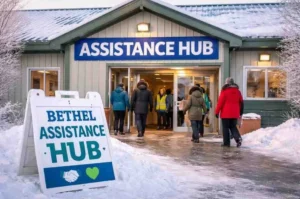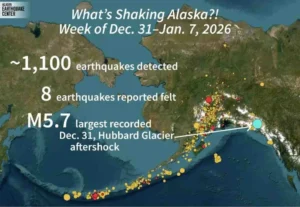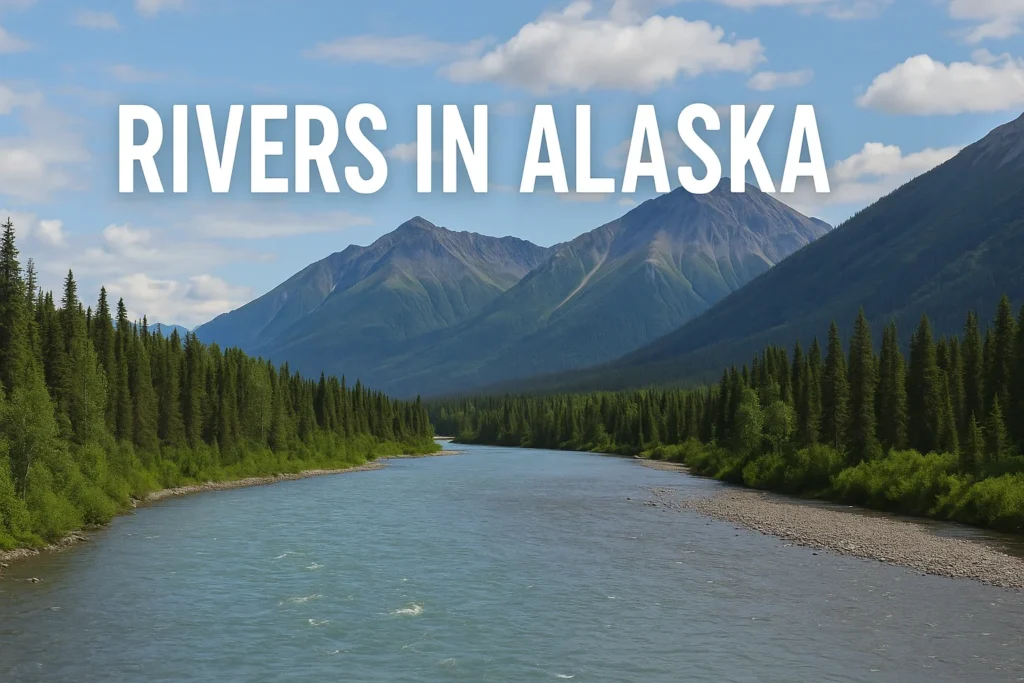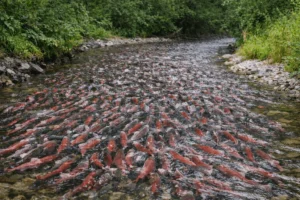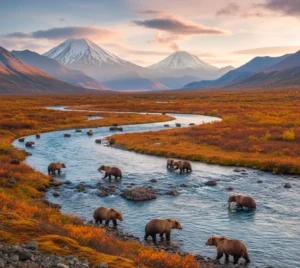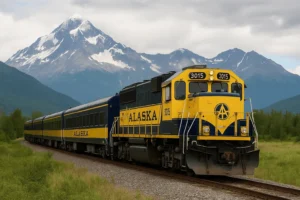Imagine a land where rivers stretch beyond the horizon, carving through glaciers, tundras, and forests. This is Alaska. With over 365,000 miles of rivers, the Last Frontier is home to the largest, longest, and most untouched water systems in the United States. And here’s the kicker, Alaska alone holds over 40% of the nation’s surface water resources.
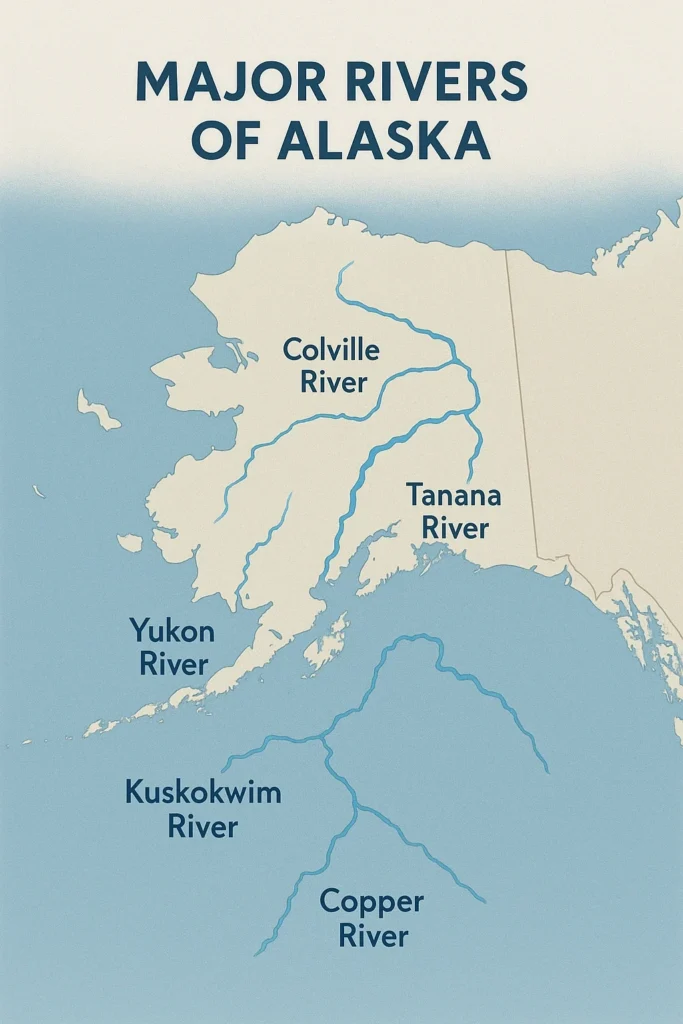
A map showcasing major rivers like:
- Yukon River
- Kuskokwim River
- Copper River
- Tanana River
This map gives a birds-eye view of how rivers dominate the state’s geography from the southeast to the Arctic coast.
📌 How Many Rivers Are in Alaska?
Alaska isn’t just large; it’s also rich in liquid.
- 🏞️ Over 12,000 rivers cut through the state’s wild terrain.
- 🧭 365,000 miles of total river length, more than 14 times around Earth!
- 🗺️ 9,728 named rivers, streams, and creeks, per USGS.
- 🧾 The USGS GNIS database lists 9,637 named streams within boroughs and census areas.
It’s no surprise that water flows through nearly every Alaskan community in some form.
📊 Top 10 Longest and Notable Rivers in Alaska
River Name | Length (Miles) | Highlights |
Yukon River | 1,980 | Longest in Alaska; Gold Rush route |
Porcupine River | 569 | Remote, rich in wildlife |
Tanana River | 584 | Central Alaska’s lifeline |
Copper River | 300 | Famous for salmon runs |
Kuskokwim River | 702 | Southwest Alaska transport hub |
Noatak River | 425 | Untouched and scenic wilderness |
Nushagak River | 242 | Commercial and sport fishing hotspot |
Kanuti River | 175 | Flows through Kanuti Wildlife Refuge |
Birch Creek | 150 | Designated “Wild and Scenic River.” |
Goodnews River | 60 | Compact but ecologically vital |
🏔️ Yukon River – The Lifeline of the Arctic
Flowing 1,980 miles, the Yukon River is Alaska’s longest and among North America’s most storied waterways. Once the artery of the Klondike Gold Rush, today it’s still essential for subsistence fishing, seasonal travel, and village resupply.
🐟 Copper River – Where Salmon Reign Supreme
Shorter in length (300 miles) but legendary in importance, the Copper River is home to one of the most iconic salmon runs in the world. Its glacial-fed waters produce millions of sockeye and king salmon every year, fueling a billion-dollar industry and feeding countless Alaskans.
🚢 Kuskokwim River – Southwest Alaska’s Artery
The 702-mile Kuskokwim River snakes through the expansive Yukon–Kuskokwim Delta. In winter, it freezes into an ice road; in summer, it becomes a highway for barges and boats, underscoring its essential role for remote communities in the region.
🌫️ Tanana River – Fairbanks’ Historic Flow
Winding through central Alaska, the Tanana River supports farming near Fairbanks, and, historically, served as a trade and hunting route. It’s a vital tributary of the Yukon, and today, it plays a role in military logistics for nearby bases.
🏕️ Nushagak, Noatak, and Other Hidden Giants
- Noatak River (425 miles) is Alaska’s wild heart, completely undammed, protected, and remote.
- Nushagak River (242 miles) boasts some of the most productive salmon fisheries in the state.
- Sheenjek River (200 miles) and Kanuti River (175 miles) attract wilderness paddlers.
- Smaller rivers like the Snow River (18 miles) or Martin River (7 miles) show how even the short ones make a big impact.
🌿 Wild & Scenic Rivers in Alaska
Out of 365,000 miles of rivers, only 3,193 miles are designated under the Wild and Scenic Rivers Act, preserving them in their natural state. That’s less than 1% of all rivers, so if you want unspoiled adventure, Alaska’s the place.
🌡️ Climate Change and River Impact
Climate change is melting glaciers that feed rivers like the Yukon, Copper, and Tanana, leading to:
- ⚠️ Earlier ice breakup
- ⚠️ Increased erosion
- ⚠️ Fish migration disruption
Rising river flows and sediment changes threaten the ecosystems and the communities that depend on them.
🏞️ Alaska’s Rivers by Borough (GNIS Data)
Region | Number of Named Streams |
Yukon–Koyukuk | 1,953 |
Nome | 1,389 |
North Slope | 653 |
Kenai Peninsula | 398 |
These numbers show how diverse and rich Alaska’s waterways are, even in the most remote areas.
🧬 Indigenous Connection to Rivers
Alaska Native cultures have spiritual and practical relationships with rivers.
- 🛶 Rivers were original travel routes.
- 🐟 Salmon and whitefish are staple foods.
- 📜 Oral histories and songs describe river spirits and events.
- 🔥 Seasonal camps are still set up along rivers for harvesting and ceremonies.
⚡ Human Use – Fishing, Power & Adventure
Alaska’s rivers are more than scenic, they power life and livelihoods:
- Fishing: Millions of salmon annually = big economy.
- Hydropower: ~25% of Alaska’s electricity.
- Transportation: Ice roads in winter, boats in summer.
- Tourism: Rafting, kayaking, and floatplane sightseeing.
🎣 Most Adventurous River Trips in Alaska
- 🐟 Kenai River: Salmon capital
- 🚣 Noatak River: Remote whitewater
- 🏞️ Gulkana River: Float trips with moose sightings
- 🛩️ Yukon River Expeditions: Culture meets wilderness
🧭 Conclusion
With over 365,000 miles of flowing water and more than 12,000 rivers, Alaska holds the largest share of surface water in the U.S. These rivers support millions of salmon, power remote communities, and shape the land and culture around them. If you’re exploring Alaska or studying its ecosystem, understanding its rivers gives you a deeper look into what makes this state so unique and vital, for both nature and people like you.
❓ FAQs
Over 12,000 rivers, plus thousands more creeks and streams.
Approximately 365,000 miles, according to USGS.
The Yukon River, at 1,980 miles, is the longest and one of the most historic.
Only 3,193 miles, or less than 1% of Alaska’s river mileage.
The Copper River and Kenai River are legendary for their salmon runs.


